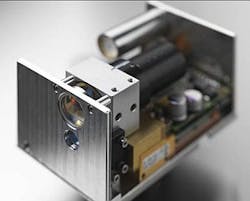Laser module for lab-on-a-chip applications by Fisba Optik
A new laser module from Fisba Optik AG (St. Gallen, Switzerland) creates optical traps by collecting and releasing particles in a microfluidic system for monitoring and manipulation, raising throughput of lab-on-a-chip applications for cell cytometry. With the module, 64 individually controllable diode lasers each shape a pixel on the printing plate every 2 ms. Intended for use in stand-alone applications and fluorescence microscope systems, the system can be equipped with any number of individually addressable laser tweezers.
More Biophotonics Products
-----
PRESS RELEASE
FISBA: Laser Module for Lab-on-a-Chip Applications
Catching Particles with 64 Optical Tweezers
FISBA OPTIK AG has optimized a laser module to create multiple individually adaptable optical traps. It enables to collect and release particles in a micro-fluidic system for particular or simultaneous monitoring and manipulation. This way it significantly raises the throughput of lab-on-a-chip applications for biochemical reactions analysis and cell cytometry.
FISBA’s laser module is compact, precise and reliable. Since half a decade it has been in continuous service in more than 10,000 plate setters for industrial offset printing machines around the world. Every two micro-seconds, each of its 64 individually controllable diode lasers shapes a pixel on the printing plate. The version designed for biotechnology uses the beams of light in a more sensitive way: As laser tweezers, they arrange molecules, cell fragments and particles inside a microfluidic system.
«This laser module helps to speed up the execution of biochemical studies, for example in pharmaceutical drug discovery processes or while testing flavoring substances in the food industry», explains René Salathé from the École polytechnique fédérale de Lausanne (EPFL), where the subassembly was tested in a new miniaturized analytical system. «Using multiple laser tweezers enables to trap and investigate cells, cell fragments and beads in a highly parallel manner».
«Lab-on-a-chip applications have an extremely compact design and present an efficient and more flexible alternative to microtiter plate procedures», says Urs Schneider from FISBA in St. Gallen, where the laser module was designed and assembled. «In order to achieve a high throughput, we used an array of 64 individually controllable diode lasers with micro optics capable of generating precise spotlights of only 10µm in diameter. They allow for examining, sorting and aligning of single particles at high speed», he adds.
Intended for use in stand-alone applications and microscope systems featuring fluorescence excitation, the system can be equipped with any number of individually addressable laser tweezers. It allows for parallel and interactive analyzing and manipulating of particles in a micro-fluidic reaction chamber. Thereby a very small solution quantity of only 0.5 µL is required at a flow rate of 0,008µL/s in the current design.
2,382 characters (incl. blanks)
FISBA OPTIK AG is one of the world’s leading suppliers of customized optical components, systems and micro systems, supplying products for medical applications, as well as biophotonics, the machine industry, industrial imaging and sensors, laser industry and aerospace. www.fisba.com
-----
Follow us on Twitter, 'like' us on Facebook, and join our group on LinkedIn
Follow OptoIQ on your iPhone; download the free app here.
Subscribe now to BioOptics World magazine; it's free!
